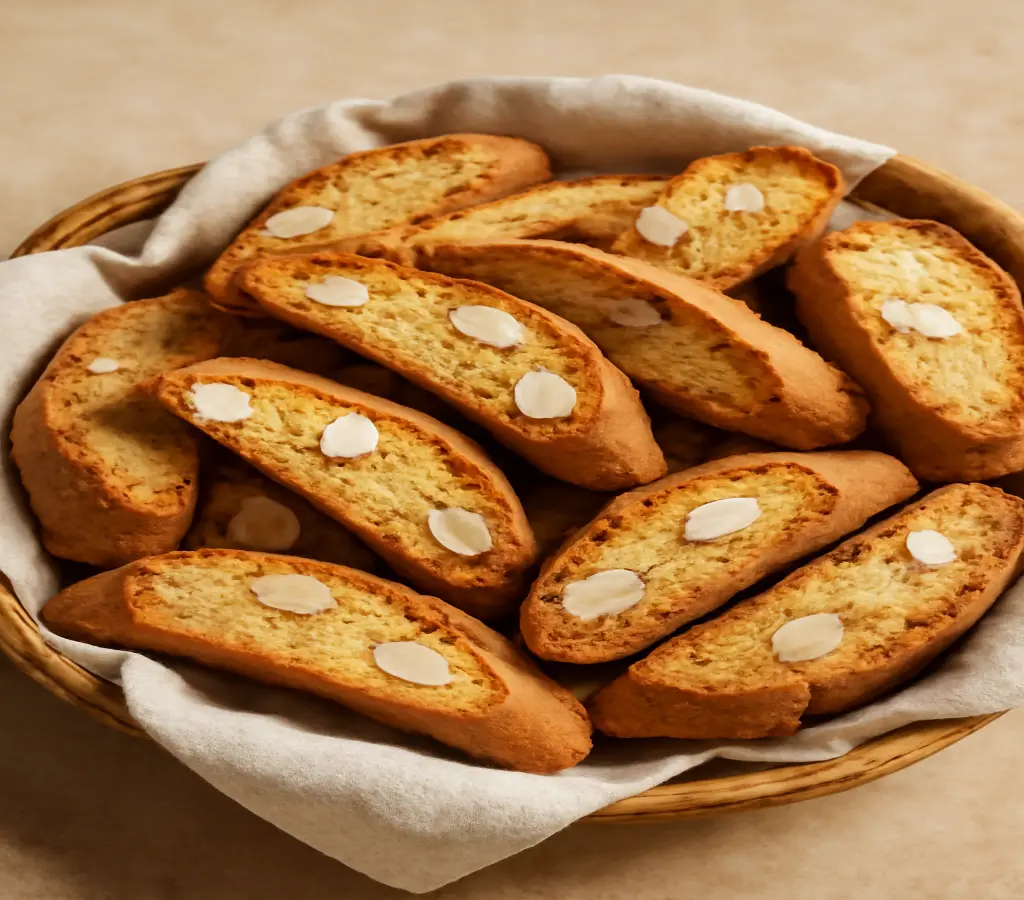What is Бишкоти ди Прато?
Biscotti di Prato, also called “Cantucci,” is an legendary Italian biscuit that has a long background that is rooted in Prato the city of the Tuscany region in Italy. The almond-scented biscuits are crunchy and are a common item in Italian homes for centuries. They are loved for their simple and delicious texture. The term “Biscotti” literally means “twice-baked,” referring to the process of baking that creates these biscuits’ distinct crunch.
Бишкоти ди Прато isn’t only a cookie It is a component of the Italian food culture, which is often consumed with a cup of coffee or with a glass of Vin Santo, a sweet Italian dessert wine. Its timeless appeal is what has enabled it to go beyond the boundaries of regional borders making it a popular snack across the world.
2. History of Бишкоти ди Прато
Origin in Prato, Tuscany
The earliest traces of Biscotti di Prato date back to the 16th century the time when these cookies were developed in Prato, the town that is now Prato. Prato has a long tradition and close nearness to Florence is recognized for its baker’s practices. This recipe of Biscotti from Prato was first developed by bakers from the area who wished to develop a lasting biscuit that could easily be transportable and store. The biscuits proved to be a great option for travellers, because they were made to last and wouldn’t be easily spoiled.
The early varieties of these biscuits weren’t so sweet as the ones we enjoy today. They were typically consumed by those of the upper class as a wine-based dessert or served at events. The recipe over time developed, and then almonds were added to the recipe, adding taste and texture. Nowadays, Biscotti di Prato is an integral part of the Italian baking culture.
The Evolution of the Biscuit
In the past over the years, the recipe of Biscotti di Prato been fairly similar. But, since the advent of industrial baking within the 20th century, the process of process has become more efficient. Although traditional methods of hand-making are still used in certain locations, contemporary variations usually contain other ingredients, such as dried fruit or chocolate.
Biscotti of Prato’s role in the history of Italy isn’t just related to its origins. It is woven within the structure of Italian tradition, frequently expressing instances of hospitality, community as well as celebration.
3. The Unique Characteristics of Бишкоти ди Прато
Texture and Taste
The main characteristic that distinguishes Biscotti of Prato is the texture. They are twice baked and are incredibly crunchy. The first bake makes sure that the dough has baked to perfection, while the second bake is crucial to achieve the distinctive crispiness. It is the result of an extremely hard, dry biscuit with a great combination of richness and sweetness. These biscuits typically contain toasty almonds that impart the flavor of nuts that compliments its sweet taste.
Biscotti di Prato is not excessively sweet. This makes it a perfect accompaniment to tea, coffee, or dessert wines. Its crunchy texture and almond taste makes it an incredibly versatile dessert which is enjoyed by all different ages.
Ingredients and Variations
The traditional Biscotti di Prato requires just three ingredients: sugar, flour eggs, almonds, eggs as well as a little salt. The ingredients are simple enough to make a delicious crisp, crunchy and slight sweet snack. Whole almonds are what set these biscuits above others. almonds being often roasted prior to being incorporated into the dough.
The traditional recipe has remained popular, different variants in Biscotti di Prato are common. There are bakeries that add dried fruit, chocolate chips as well as spices such as anise or cinnamon to provide a different twist to the traditional recipe.
4. The Traditional Recipe for Preparing Бишкоти ди Прато
Step-by-Step Recipe
Making Бишкоти ди Прато at home is a simple yet rewarding process. This is a classic recipe to make:
-
Ingredients:
-
2 cups all-purpose flour
-
1 cup of sugar
-
3 large eggs
-
1 1/2 cups almonds in whole (toasted)
-
1 teaspoon vanilla extract
-
1 teaspoon baking soda
-
Salt and a pinch
-
-
Instructions:
-
Preheat your oven at 350 degrees F (175degC). Prepare a baking sheet using parchment sheet.
-
In a large mixing bowl mix the sugar, flour baking powder, salt.
-
In a separate bowl mix the eggs with vanilla extract until they are well mixed.
-
Then, gradually add all wet ingredients to dry ingredients and stir until the dough is formed. The dough should appear a little sticky.
-
Fold gently in the toasted almonds. Make sure that they’re evenly distributed across the dough.
-
Divide the dough in two equal portions. Form each one into a log that is 12 inches long. Place them on the baking sheet.
-
Bake for about 25 to 30 minutes up to the point that they turn golden brown. Removing them from the oven, allow them to cool for around 10 minutes.
-
When the logs are cool, cut the logs in half-inch wide slices. Place the pieces flat on the baking sheets and bake them for another 10 to 15 minutes, or until the slices are crispy and crispy.
-
Baking Tips
-
It is important to ensure that the dough is a little sticky as this will aid in creating the crisp appearance after being baked two times.
-
Take care not to over-bake the biscuits after the second time, since they could become tough to chew.
5. Modern-Day Popularity of Бишкоти ди Прато
Biscotti Around the World
Biscotti from Prato is now a global phenomenon, readily available in grocery and bakeries all over the world. The distinctive texture and the diversified flavour have earned its place in the heart of many people across cultural backgrounds. Although the classic almond flavor is the most loved, new flavors that incorporate chocolate, pistachios or dried cherries, can be discovered in bakeries across the world.
Biscotti in Popular Culture
Biscotti di Prato has appeared in appearances in films, cookbooks and television shows. It is a symbol of Italian sophistication and culinary excellence. The food is usually portrayed as an elegant snack perfect to serve with a cup of coffee while having a casual chat or to enjoy following dinner. The fact that it is a part of popular culture further confirms its position as an iconic delight.
6. How to Serve and Enjoy Bishkoti di Prato
Combining with beverages
Бишкоти ди Прато are traditionally consumed with a drink. The most popular pairing is Vin Santo, an incredibly delicious sweet Italian dessert wine. However, there are many who prefer the drink with an tea or espresso. The dry texture of the biscuits is ideal for dips in the flavor of the beverage without getting too wet.
Serving Suggestions
The biscuits can be enjoyed at every occasion. Enjoy them with afternoon tea, or after dinner as a delicious dessert, or even to give as gifts for your friends or family. Their longevity on the shelf as well as the possibility of making them in huge quantities makes these a useful and delicious element to any party.
7. Variations of the Classic Recipe
Regional Differences
Although Biscotti of Prato is usually linked to Tuscany However, many regions of Italy offer their own variations of the recipe. Some regions, the biscuits could contain aniseed, or local spice, however, in other areas the biscuits may contain richer ingredients such as citrus zest or chocolate chips.
Modern Twists
The latest versions to Biscotti di Prato include flavors such as dried cranberry, pistachio as well as chocolate. A few versions are also made using gluten-free flours which makes these biscuits suitable for those who have food restrictions.
8. Health Benefits and Nutritional Information
Is it Healthy?
Бишкоти ди Прато, like many classic Italian desserts are a sweet treat to be consumed in moderate amounts. It’s fairly lower in fats, particularly when it is made using a low amount of sugar and is a fantastic source of fiber because of the almonds. It is important to be aware that its sugar content makes it a high-calorie snack.
Modifications for Health-Conscious Consumers
If you’re trying to improve the healthiness of this recipe try using almond flour to make an alternative that is gluten-free or substitute certain sugars using natural sweeteners, such as honey or Stevia.
9. Baking Tips and Troubleshooting
Common Problems When Making Biscotti
One of the biggest difficulties with making Biscotti of Prato can be reaching the correct texture. If the biscuits appear too firm or soft this may be because the dough being too moist or being overcooked during the next round. Making sure that you bake your biscuits at the correct temperature and in the right duration is crucial to get the best results.
How to Store Biscotti
Biscotti can be kept in airtight containers for approximately two weeks. For them to stay fresh, be sure that you cool them completely prior to storing.
10. Conclusion
Biscotti from Prato much more than just a simple biscuit, it’s a tribute to the rich history of Italian cuisine. If you like it alongside an espresso and dessert at the end of dinner, or just to snack on throughout the day, this classic snack brings a taste of Tuscany into your kitchen. Its simple, crisp texture and its versatility make it a popular choice for many and the tale will be handed down over generations. Make a batch of Biscotti di Prato at home or explore the varieties that are available at local bakeries. No matter which you prefer, Biscotti di Prato will remain a beloved element of Italian tradition.
Also Read: Перекладач (Translator): Bridging Language Barriers
For more engaging content and the latest updates, follow Bunkknot for insightful articles and fresh perspectives!
Also follow: mastodon.social/@bunkknot


